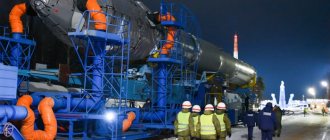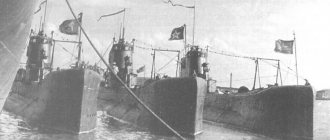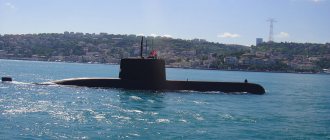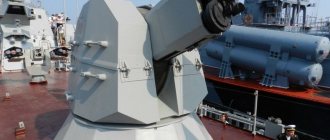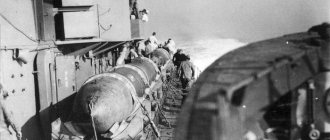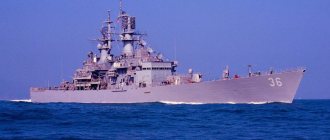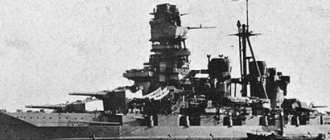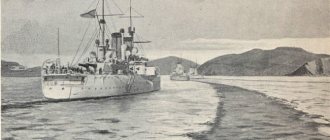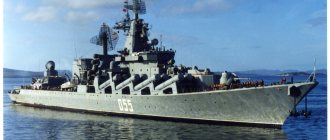Creation and deployment of the 5th squadron
The parade was planned in the area of the Greek island. Kythira, where point No. 5 was determined for the squadron’s anchorages. There were more than 60 of them throughout the Mediterranean Sea, but this point later became, as it were, the starting position of the ships arriving in the squadron to replace those leaving. It only took two days (July 6 and 7, 1967) for the squadron commander to fly to Moscow with the BS plans and the parade disposition and approve them with the Commander-in-Chief of the Navy. I had to hurry, because... The deadlines for the start of activities of the 5th squadron were set strict.
BOD "Admiral Panteleev"
On July 9, 1967, at 10.00, the destroyer "Noble" under the flag of the Deputy Civil Code of the Navy, Fleet Admiral V. Kasatonov, left Sevastopol to proceed to the Mediterranean Sea, where a parade of ships was planned at point No. 5 on July 15. On board the destroyer were the squadron command and several other officers making up the first echelon of the headquarters. The next day, the patrol ship "Jaguar" left Sevastopol with the second echelon. During the transition on July 10, the Noble received a radiogram from the Navy Civil Code about a change in plan: the squadron commander and headquarters were ordered to proceed to Alexandria (Egypt), where from 0.00 on July 14 to take control of the squadron. There was no confirmation of the parade in the radiogram.
Even during the visit of the Chairman of the Presidium of the Supreme Soviet of the USSR N.V. Podgorny to the UAR on June 21-24, during meetings, Egyptian President Nasser raised the issue of the possibility of Soviet warships calling at the ports of the UAR. At the same time, Nasser declared his country’s readiness to provide all the necessary conditions for this. Taking advantage of the opportunity, on July 9, the Commander-in-Chief of the Navy ordered the ships of the 14th squadron in three detachments to go on a business visit to the ports of Egypt and Syria. On July 10, 13 ships of the 14th squadron arrived in Alexandria and Port Said for a week-long visit, including the KR Dzerzhinsky, the BOD Komsomolets of Ukraine, and the EM Plamenny. The commander of the detachment of ships, Rear Admiral I.N. Molodtsov, stated that his ships were ready to “repel any aggression.” Residents of Egyptian cities arranged a solemn meeting for Soviet sailors. The governor of Alexandria highly appreciated the Soviet Union's support for the fighting Arab peoples. At the same time, Soviet ships arrived at the Syrian port of Latakia.
July 11 in the area north of the island. Crete, the squadron commander and staff officers moved from the destroyer to the floating workshop PM-26, which went to Alexandria, and the Noble with Fleet Admiral V. Kasatonov (with Rear Admiral N. Renzaev) headed from the island to the south. There was a meeting with nuclear and diesel submarines to check their combat readiness. On July 12 at 18.30 PM-26 moored at the New Alexandria Pier. The squadron commander and headquarters boarded the Komsomolets of Ukraine BOD. At 10.00 on July 13, operational duty was established for the 5th squadron of Navy ships. The first OD was captain 2nd rank R. Zubkov, his assistant was the squadron's assistant flag signalman, captain 3rd rank Yu. Gaevsky.
Large anti-submarine ship pr.61 “Komsomolets of Ukraine” in the Mediterranean Sea. October 1973
On July 14, 1967, order No. 0195 was issued by the Commander-in-Chief of the Navy on the formation of the 5th operational squadron, and Rear Admiral B.F. Petrov took command of all forces located at that time in the Mediterranean Sea. This day became the day of the formation of the Mediterranean squadron.
Squadron organizational system
Organizationally, the 5th squadron was built according to completely different principles compared to other squadrons of the USSR Navy. The uniqueness of the squadron was that its composition was formed by ships of the Black Sea, Northern and Baltic fleets for the duration of combat service for 4-6 months, with subsequent replacement by other ships. The administration, headquarters and political department existed on a permanent basis, with continuous stay at sea on the flagship ship. The squadron reported directly to the Commander-in-Chief of the Navy. To carry out control, a special control post for the 5th squadron was deployed at the Navy Central Command Center.
In accordance with the directive of the General Staff of the Armed Forces, the headquarters of the squadron was staffed according to staff No. 59/708, that is, according to the staff of an ordinary internal squadron of naval subordination, which provided for: admirals and officers - 29, foremen and sailors - 8. The practice of the headquarters showed that for control With such a heterogeneous association on a huge theater and in such a complex military-political situation, there are clearly not enough people, especially operators. Therefore, over time, the number of personnel at the headquarters gradually increased. Initially, the squadron headquarters was located on the Komsomolets of Ukraine BOD, stationed in the port of Alexandria. Accommodating and controlling a squadron with a BOD was inconvenient due to insufficient space on the ship and difficult due to limited communications. Therefore, a little later, the squadron headquarters moved to the Dzerzhinsky KRL, which actually became the first flagship of the 5th squadron. The cruiser had everything provided for the headquarters: cabins for living and working of officers, a flagship command post, and communications equipment for control. However, over time, for the full control of the forces of the squadron, which were quite significant, the capabilities of the communications equipment still became insufficient. This situation was corrected with the arrival of the Zhdanov control unit, converted according to project 68-U-1, to the squadron, where a radio communications division with the appropriate equipment was organizationally provided in the communications combat unit. With its help, the squadron headquarters was able to constantly maintain two-way communication through 27 channels. Recognition of the successful start of operations of this squadron was the assignment of regular military ranks to many headquarters officers by November 7, 1967. The squadron commander B. Petrov was awarded the rank of vice admiral.
With the formation of the squadron in the Mediterranean Sea, a coherent organizational system was built, consisting of six operational formations with the following tasks and areas of operation:
- 50th OS - a command ship with escort, the location of the action - depending on the situation and the tasks being solved;
- 51st OS - submarines (6-8 units), in the central and western parts, search for SSBNs;
- 52nd OS - attack missile and artillery ships, tracking aircraft carriers when entering the central and eastern parts of the sea;
- 53rd OS - anti-submarine ships, jointly with aviation and submarines, searching for SSBNs in the central and western parts and along their deployment routes;
- 54th OS - landing ships (2-3 units) and a fire support ship - Port Said, a battalion or company of marines with equipment;
- 55th OS - ships and support vessels (tankers, aquarians, floating workshops, rescue ships, tugs, diving, food, floating barracks, floating warehouses, etc.)
For operational formations, formation commanders were appointed from among the brigade commanders, chiefs of staff and the most experienced ship commanders who came to combat service, as well as deputy commanders of formations for political affairs from among the deputy brigade commanders or “big deputies” (deputy commanders for political affairs on cruisers).
Links
- Militera, A. I. Radzievsky, Tank attack., M., Voenizdat, 1977.
| Organization of troops (forces) | |
| Ground troops |
|
| Naval forces |
|
| Air Force |
|
Main tasks of the 5th squadron
The main tasks solved by the 5th Squadron during combat service can be divided into political and military. The political goals included the following:
- preventing the unchallenged dominance of the NATO Navy as a whole and the US Navy's 6th Fleet in the Mediterranean;
- preventing NATO naval forces from interfering in the internal affairs of countries fighting for their national independence;
- support for the national liberation aspirations of the peoples of developing countries;
- displaying the flag and supporting foreign policy actions and actions of the country’s government in resolving interstate crises and problems arising in the region;
- visits and business calls to foreign ports.
Military goals were determined primarily by the need to counter possible actions of the US 6th Fleet both in the event of a global conflict and during local clashes. In general, during combat service the 5th squadron solved the following tasks:
- disrupting a possible attack by the NATO Navy on the territory of the Soviet Union and its allies;
- tracking aircraft carrier strike groups and other strike groups of the naval forces of a potential enemy in readiness for the use of weapons by a strike group of ships, with the inclusion of nuclear submarines with missile weapons in the command group;
- monitoring the opposing forces of foreign fleets and their maneuvering;
- search and long-term tracking of foreign SSBNs and other submarines in readiness to destroy them upon order, identifying their patrol areas;
- conducting all types of reconnaissance;
- practicing command and control of forces in direct contact with a group of forces of a potential enemy, both from a coastal command post and from a control ship;
- ensuring the safety of navigation in the area of operation.
Patrol ship pr.1135 in the bay of Sevastopol, 1973 PM
The combat service of the 5th squadron in direct contact with the enemy, and often in visual visibility, was distinguished by high visibility. If the enemy at the base is hypothetical, then in the Mediterranean Sea - here it is, the concrete 6th American fleet with three newest attack aircraft carriers, each on board about 80 aircraft with nuclear weapons, with a dozen SSBNs, each of which has 16 ballistic missiles. And all this is aimed at the native country. At the base, the task is to maintain ships at a high level of combat readiness in the event of hostilities in general. In combat service, the specific task is to prevent, by any means, the massive rise of aircraft from enemy aircraft carriers and the launch of ballistic missiles from SSBNs, and to be in immediate readiness to destroy them with the start of hostilities.
Air fleet and armored forces
The world's very first squadron in the air fleet was an association of airships called “Ilya Muromets”. It was created during the imperial period in the Russian Armed Forces.
As for the armored forces, in 1923 this term was used to describe a relatively large association of armored forces in the Red Army. It emerged from small separate auto-tank detachments and armored detachments, from which such a formation as a “squadron” of tanks was formed. It included two flotillas: heavy and light.
The role of the Black Sea Fleet
The main burden of combat service in the Mediterranean Sea fell on the shoulders of the Black Sea Fleet. The fleet formed the main attack, anti-submarine, landing and minesweeper groupings of ships. He was entirely responsible for the logistical support of the squadron. The Northern Fleet constantly carried out combat service with nuclear submarines and a brigade of diesel submarines, periodically sending surface ships. The Baltic Fleet occasionally participated in combat service with surface ships.
The fleets sent first-line ships to combat service, that is, those that completed all course tasks, combat exercises, were fully staffed with personnel, full ammunition and other types of supplies to full standards, technically serviceable, with a reserve of motor resources for the entire period of combat service. Additionally, they had to have a trained landing unit from their crew with appropriate weapons and equipment. Thus, the ship sent to the Mediterranean Sea as part of the squadron was fully combat-ready. The arriving ships, by order of the squadron commander, were assigned to operational formations in accordance with their purpose: attack missile and artillery - to the 52nd operational formation, anti-submarine - to the 53rd.
Squadron in the 18th century
The main formation in the navy in the 18th century was the division. The squadron included three divisions.
- The first was the corps de battle, which was located in the center of the battle formation. It was headed by an admiral, who commanded the entire squadron.
- The second is the vanguard, leading the battle formation, led by the vice admiral.
- The third was the rearguard, which brought up the rear of the battle formation, led by the rear admiral.
The number of ships depended on how many battleships there were in the fleet. In addition to them, the squadron also included frigates, kicks, galleys, shnyavas, hookboats, fire ships, bombardment ships, and other military vessels. Staffing was carried out taking into account the assigned tasks.
Basing of the 5th squadron
By agreement with the leadership of Egypt, maneuverable basing of ships and vessels of the squadron was organized in the port of Alexandria. For this purpose, 100 meters of the berth line were allocated, where support vessels were constantly located: floating workshops, a floating dockyard, a floating warehouse and military transport. Periodically, submarines came here to carry out inter-cruise repairs and rest personnel. From here the ships of the squadron were supplied with fresh food and drinking water. According to the squadron's plan, surface ships also visited to provide rest to the crews. Repairs of submarines were carried out by personnel with the involvement of equipment and specialists from floating workshops. The most complex work was carried out at the shipyard, built by Soviet specialists in order to provide assistance to the Egyptian people. There was also a logistics support point in Tartus, Syria. There was usually a floating workshop, a boat with divers, a floating warehouse with the necessary equipment and food, and a tugboat.
PM-138 enters the Egyptian port of Alexandria. October, 1973
The surface ships were based at anchorages outside the territorial waters of Greece, Turkey, Malta, Egypt, Syria, Tunisia and Algeria. In case of stormy weather, they drifted behind the islands of Cyprus and Crete, sheltering from the winds. Submarines were usually submerged in positions in designated areas. To the north of Alexandria, in places free from shipping, combat training ranges were identified, where ships carried out missile, artillery and torpedo firing, and solved anti-submarine training tasks with bombing.
In the Mediterranean Sea, our submarines began to carry out combat service, first as single ships, and then in brigades of 8-10 submarines. Duration - six months, while the boats secretly moved from the Northern Fleet to the place of duty. Alternately, their crews carried out inter-cruise repairs in Alexandria for a month. During the repairs, the crew moved to the floating barracks. The Commander-in-Chief at that time considered it irrational to spend six months in combat service: a month for the transition to the duty station, a month for the return transition to the base, and a month for inter-cruise repairs. A total of three months of purely combat service with a huge consumption of motor resources. Therefore, later S.G. Gorshkov ordered the transition to a one-year cycle with the organization of crew changes.
As a rule, the 5th squadron constantly had in combat service four nuclear submarines, ten diesel submarines, two KUG - ship strike groups, one KTG - minesweeper group, and support forces - four tankers, two floating workshops, refrigerators, etc. Typically, a squadron consists of 70-80 pennants, of which fourteen are submarines, 25-30 are warships, and the rest are support vessels.
Large anti-submarine ship pr. 1134B "Nikolaev". Mediterranean Sea, October 1973
Further transformations
During the reign of Paul I, in 1797, a new naval charter was issued, which included changes in the organizational structure of the fleets. There, squadrons began to be called divisions, and divisions - squadrons.
When steam armored ships appeared in active fleets, the main combat units were such associations. They consisted:
- from brigades including battleships and cruisers;
- barrage detachment;
- destroyer division;
- support vessels.
In 1914, the Russian fleet squadron was formed as follows:
- a division consisting of eight battleships;
- a brigade of four armored cruisers;
- a division of eight cruisers;
- a division consisting of destroyers (one cruiser and 36 destroyers).
Divisions of cruisers and battleships were divided into brigades, each of which had four ships. The destroyer division had two brigades, comprising two divisions, and the division had nine ships.
Combat missions of the Mediterranean squadron
The typical task of KUGs and SSNs armed with anti-ship missiles was to track enemy aircraft carrier groups at launch range. Typically, forces were distributed so that no less than thirty missiles were aimed at each aircraft carrier. Next to each aircraft carrier there was always a direct tracking ship (CNS), which detected every takeoff of an American carrier-based aircraft and transmitted this data to the command post. According to information from the KNS, target designations for NATO aircraft carriers were constantly issued to all attack ships and boats of the squadron every sixty minutes: their location, course and speed. Thus, our missiles were always aimed at their aircraft carriers. And our ships, of course, were also in the Americans’ sights. Moreover, twenty-five percent, that is, every fourth of our missiles, were equipped with nuclear weapons. So, for example, on the SSGN Project 670 there are eight Amethyst missiles on the boat, two of them with nuclear warheads. The Slava missile launcher, project 1164, has sixteen Basalt missiles, four of them with nuclear warheads.
We measure our muscles. Ours are stronger!
Calculations showed that in those years the US Navy AUG was capable of shooting down twenty-two missiles. The aircraft carrier has already caught the twenty-third missile on its side. They could shoot down the twenty-fourth again, but then miss three in a row, and so on. That is, if we exceeded twenty-two missiles in a simultaneous salvo, we already hit the main target with a high degree of probability - the aircraft carrier. But as Rear Admiral Selivanov recalls: “...to be honest, I never believed that the Americans would really be able to shoot down all the first twenty-two missiles. I am sure that this number would not exceed ten. I have observed the combat training of their anti-aircraft gunners many times. They always fired only at parachute targets. For us, this was not even considered shooting; we never fired at parachute targets. It's just a laugh, a giveaway! We always shot practical rockets. Those that clearly fly at you, at real speeds, from different directions... At the same time, our missiles are smart, if they encounter a less interesting target, they miss it and look for something larger. If there is a destroyer on the way to the aircraft carrier, then the missile will bypass it from the right or left side and fly to the target with a larger reflective surface, that is, it will find the aircraft carrier. Moreover, the accuracy of our missiles is simply phenomenal. I have seen dozens of training missile launches and almost always they hit not just the target, but also the geometric middle of the target. ...So we were proud of our weapons, our weapons were respected. Therefore, I am sure that the Americans would never have shot down our twenty-two missiles in the event of war! And, as I already said, there were at least thirty of them for each AUG!”
BOD parking lot in Sevastopol, 1973
The latest SSGN Project 670 "Skat" (type "Charlie I" according to NATO classification) with the Amethyst missile system, and later the SSGN Project 670M "Skat-M" (according to other sources " Chaika", type "Charlie II" according to NATO classification) with a more powerful and long-range "Malachite" complex. Appearance in the 70s. new missile carriers in the Soviet fleet significantly “complicated life” for American aircraft carrier formations. Being less noisy than their predecessors - SSGN pr.675, the Stingrays were much less vulnerable to enemy anti-submarine weapons, and the underwater launch of missiles made the use of their “main caliber” much more effective. The relatively low firing range of the Amethyst complex required approaching the target at a range of 60-80 km. However, this also had its advantages: the short flight time of transonic low-altitude missiles made organizing counteraction to their strike from under water from a “dagger” distance very problematic, and the relatively short firing range allowed the SSGN pr.670 to search for a target and carry out a missile attack using its own SAC, without receiving target designation from external sources. The presence of the Stingrays caused well-founded concern among the American command, which did not have at its disposal any reliable means of countering this threat.
Origin
Regarding the origin of the word being analyzed, the etymological dictionary says that it came to the Russian language from French, where there is a noun escadre. The latter, in turn, is derived from the Italian word squadra, which translates as “team, squad.” Initially it was interpreted as a “quadrangular battle formation.”
This lexeme was borrowed by the Italian language from Vulgar Latin, formed from the noun exquadra. And it comes from the verb quadrare, which translates as “befitting, making quadrangular.” The verb itself is formed from the noun quadrum, meaning “quadrangle, square” and derived from the numeral quattuor - “four”. According to etymologists, the latter goes back to the Proto-Indo-European basis kewtwor.
In continuing to study what a squadron is, it would be advisable to consider some historical facts related to this concept.
Aviation tasks in a potential conflict
In the event of a possible conflict on targets in the Mediterranean Sea, the aviation of the Black Sea Fleet was also supposed to work: 5th Guards MRAP (Veseloye airfield, Tu-16K, later Tu-22M3), 124th MRAP (Gvardeyskoye airfield, Tu-16K), 943rd MRAP (Oktyabrskoye airfield, Tu-16K, later Tu-22M3), as well as other units armed with Tu-22 of various modifications. So, for example, regiments armed with Tu-22K could be used to strike aircraft carrier groups of the US 6th Fleet (and by the early 70s, the Tu-22 as a combat system had already been brought to a high degree of perfection). It was assumed that, having passed over the territory of the socialist allied countries, the planes would reach the Balkans and further into the Mediterranean. The operation to destroy the aircraft carrier should have involved at least four Tu-22R reconnaissance aircraft, up to a regiment of Tu-22K missile carriers and one or two squadrons of fighters. Tu22R went first. Their task is to identify the aircraft carrier from all the AUG ships and report its coordinates to the strike group (subject to the first strike, this function can be performed by a direct tracking ship). When approaching the ships, one pair of Tu-22Rs remained at altitude to jam and relay intelligence information, the second “fell” to a height of 100 m and broke through to the AUG at a visual contact range of 10-15 km (and this is quite possible with the help of cover fighters , especially since the air defense capabilities of the AUG will most likely be weakened by the attack of the ships of the 5th squadron, and their air defense systems will also not stand idle). As soon as an aircraft carrier was detected, the number of its “square” was communicated to the missile carriers, who launched launches from a line of about 300 km.
The cruiser "Admiral Ushakov" in Messina, October 19, 1973 Photo from S.T. Kalinin's demobilization album.
Another important task solved by the squadron was searching for and tracking submarines of a potential enemy and conducting anti-submarine operations. The solution to this problem was entrusted to multipurpose submarines, anti-submarine aircraft and naval search strike groups. Various tactics were used to search for and track submarines. So, our submarines could be deployed as a screen; another option was to patrol them in given areas. The search for submarines of a potential enemy using the KPUG was carried out both during anti-submarine search operations and in everyday combat activities. Of course, it cannot be said that we constantly controlled all the submarines of a potential enemy - but nevertheless, the number of detections and escorts of enemy submarines was quite large, and it is quite possible to say that a possible attack on the territory of the Soviet Union from SSBNs in the Mediterranean Sea would be serious weakened by all means of anti-submarine defense.
Reconnaissance and anti-submarine aircraft were actively operating over the Mediterranean Sea. For some time, Tu-16R reconnaissance aircraft (six aircraft, 90th ODRAEON) with Egyptian markings flew from Cairo-West and Mersa Matrouh airfields. Over time, their number was increased to a regiment. Also, from August 19, 1968, Black Sea Be-12s were based at the Mersa Matruh airfield (three aircraft from the 318th OPLAP DD, assigned to the 90th ODRAEON). It was planned that the Be-12 would perform 3-4 sorties per week, lasting 3-4 hours each. In fact, the Be-12’s operations were not carried out within such strict limits, but mainly at the request of the command of the 5th squadron. But it was in cooperation with the 5th squadron that the first two detections of submarines with Be-12 were obtained; tracking was carried out for 1 hour 37 minutes and 0 hour 48 minutes. Since the fall of 1970, Il-38s with Soviet crews and with identification marks of the Air Force of the Arab Republic of Egypt were conducting reconnaissance in the Mediterranean Sea. Also, from February-March 1970, formations of our air defense forces and fighter aircraft were deployed in Egypt. One of their tasks was to cover our ships: anti-aircraft fire - in bases and ports, fighter fire - at sea within the reach of fighters. In the mid-70s, after concluding a truce with Israel, Egypt fell out with the Soviet Union, and our pilots and anti-aircraft gunners returned to their homeland. But the Il-38 continued to carry out reconnaissance raids from airfields in Syria and Libya, including to monitor the actions of American battleships during the 1982 Lebanon War.
At the 5th Squadron, tactical techniques for using naval forces were improved, the actions of tactical groups, operational brigades, search and strike groups, landing detachments and operational rear units were practiced. For twenty-five years (1967-1992), not a single disaster or serious accident occurred on the squadron.
Combat service in the 5th Special Operations Squad of the Navy became a serious school for all the personnel of the sailors, foremen and officers of ships, a practical test of the professionalism of the leadership of the operational-tactical formation. Highly qualified specialists who formed the basis of the squadron headquarters, demonstrating the talent of extraordinary organizers, subsequently occupied responsible positions in various governing bodies of the Navy. For a long time, the 5th operational squadron of the Navy served as a reliable tool for protecting the interests of the state.
